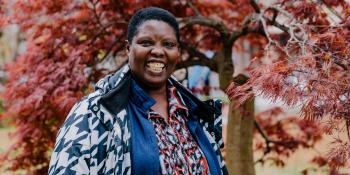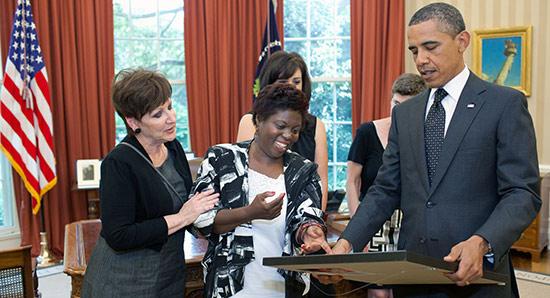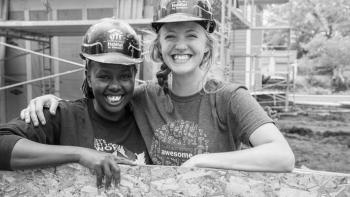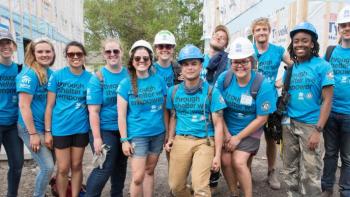
Everyone belongs in the Beloved Community
On a cool spring day, Lois Curtis sits in a public square in Georgia and talks about how she likes to fill her days.
“I go to the library and check out books,” says Curtis, with a grin that lights up her entire face. “I like to go to pottery class, music class, church. I like to walk around my neighborhood.”
These seemingly ordinary events are anything but for Curtis, the “L.C.” in Olmstead v. L.C., the landmark civil rights case that paved the way for people with developmental disabilities and mental illnesses who want to live in community settings instead of institutions.
In 1999, the U.S. Supreme Court held in Olmstead that isolating people with disabilities in facilities when they can live in the community with support is a form of discrimination.
Almost two decades later, Curtis and an untold number of others across the country now can worship where they want, take pottery classes if they are so inclined and walk around whatever neighborhood they decide to put down roots. In other words, they can live like everyone else.
It is not just people with disabilities who are the beneficiaries of the Supreme Court’s decision, says Susan Walker Goico, who directs the Disability Integration Project for the Atlanta Legal Aid Society, which represented Lois.
“I firmly believe everyone belongs in Dr. King’s ‘Beloved Community,’” she says. “When we institutionalize people, we are missing out on all of the contributions that they can make. We will benefit from them being in our neighborhoods as much as they will benefit.”
The people who pass by Curtis seated in the square seem to have no idea how remarkable this scene is or what a transformational figure they are looking at. If Curtis knows, she doesn’t let on. Mostly, she is enjoying being out and about. It took her a long time to get here.
The Americans with Disabilities Act
Curtis, who is developmentally disabled and being treated for several mental illnesses, was first institutionalized when she was 13. She spent the next several decades in and out of facilities.
As an attorney with Atlanta Legal Aid, Sue Jamieson remembers in the years before she filed suit for Curtis getting many calls from her client and hearing the words on the other end of the phone, “I want out.”
Jamieson succeeded on multiple occasions in getting Curtis released from a state hospital, but there weren’t the services or the funding in place to help her succeed. “Lois was re-institutionalized, and there was nothing I could come up with to get her out since the state was not obligated under Georgia law to provide community services,” says Jamieson, who retired in 2014.
Then Congress passed the American with Disabilities Act of 1990, a federal civil rights law that prohibits discrimination based on disability.

Five years later, Curtis sued in federal court against the State of Georgia and the Department of Human Services Commissioner Tommy C. Olmstead for violating the ADA. She and another plaintiff added to the case, Elaine Wilson, who also had developmental disabilities and mental illness, sought disability services in the community. Wilson enjoyed eight years in the community after her release from a state institution before her untimely death in 2004.
The scene on the day the Supreme Court heard Olmstead was momentous on several fronts, says Jamieson, who did not argue the case but accompanied Curtis and Wilson to the proceeding.
“I was very oriented toward individual advocacy,” Jamieson says. “To me, the Supreme Court decision finding that the ADA applied to the unnecessarily institutionalized meant that Lois and Elaine would get a break and have a life in the community, and I could use the case to advocate for other people. I probably didn’t even perceive the broader impact of the case at the time.”
The impact became clear when dozens of advocacy organizations wrote briefs in support of Curtis and Wilson. When the women and Jamieson arrived at the court, they were met by hundreds of supporters with signs, many in wheelchairs, who had spent most of the night camped out on the courthouse steps.
“It was overwhelming,” says Jamieson, who also remembers thinking what a huge setback it would be for disability rights if the Supreme Court ruled against them. “That battle had been going on for many years before Olmstead,” she says. “Thank God we got the court on our side.”
A sea change for people with developmental disabilities
The Olmstead decision marked a huge sea change because it required states and other public programs to provide services in the “most integrated setting.” States began redirecting resources from institutions and toward community-based services. “You can look around at any state and their focus today is moving people into the community,” Jamieson says.
Curtis is able to live in her own apartment and get around with the help of a caregiver. In 2011, on the 12th anniversary of the Olmstead decision, she traveled to the White House and was honored by then President Barack Obama. She presented Obama with one of her original paintings, a self-portrait called The Girl in Orange Dress.
Although Olmstead was a turning point, there still is much more to be done so that even more people with disabilities can have a life outside of an institution. Barriers include inadequate funding for services, lengthy waiting lists, overly stringent eligibility criteria, and too few qualified providers to support people in the community.
“We are still advocating for people with disabilities who are striving to live in the community and can’t get there for one reason or another,” Goico says.
Because of a girl in an orange dress, hopefully more people will get their chance to spend a cool spring day sitting outside in a public space.

